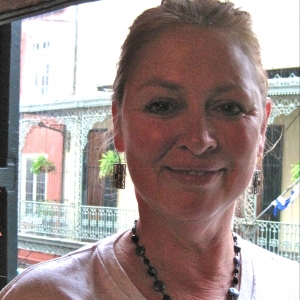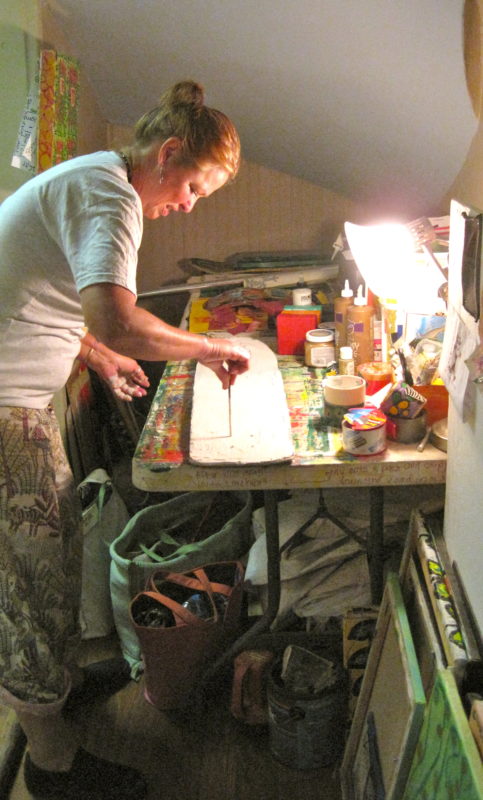On a cold and damp Monday afternoon in the French Quarter, artist Carrie Curtis is parked in her usual spot behind St. Louis Cathedral. Bundled in a colorful scarf, smiling broadly, and standing beside her cheerful, bright creations, she contrasted the gray dreariness of the sky. One of her most noticeable pieces is a large, mixed-media painting of a yellow guitar on a background of peace signs and daisies, inscribed with the slogan “Grow Your Own Music.” When asked what “Grow Your Own” means, Carrie explained, “It’s referring to whatever you do in life, do it in a positive direction and make it yours–grow your own!”

Artist Carrie Curtis. Photo by Heidi Schmalbach.
A few days later in her home and studio just a few blocks away, I learned that Carrie lives up to her slogan, and even holds the copyright. She arrived in New Orleans in 2012 with a moving van and a plan: to sell her artwork behind the “300-year-old church” and to live in the French Quarter in a small apartment that could function as an art studio, and only with a balcony. It was a vision she had created over the past 30 years during frequent visits to New Orleans from her home in Winter Park, Florida, often for annual celebrations such as Jazz and French Quarter Fest. When she turned 50, Carrie says she finally decided “this is the time for me,” and set forth on making her dream a reality. “I went online for 24 hours a day to find this place,” she laughs and shrugs, “and it’s exactly what I wanted!”
On this particular morning, Carrie’s balcony was mostly unusable due a torrential rainstorm. Peeking out over a railing draped in Mardi-Gras beads, Carrie points out her excellent view of the famous Antoine’s restaurant while describing the personalities and professions of the characters who live or work on her street. We both agree that the French Quarter is perhaps its most beautiful in the pouring rain; though Carrie points out one might have to remove their shoes to avoid ruin by “quarter juice”: the collection of car run-off, stale booze, and various other elements that accumulate in tiny lakes too wide to jump. Carrie says this view provides a consistent source of inspiration for her artistic work. She has a painting in progress on an easel a few feet from the balcony entrance, and a couple small pieces on salvaged wood “drying” outside in the humid rain. Many of the materials Carrie uses in her art pieces are recycled or donated, including old wood from renovations and used skateboard decks. Today, she doesn’t seem concerned that the pieces are getting soaked; “they’ll be fine,” she says, “and if they’re not, I’ll start them over again.”
While this laid-back response is characteristic of Carrie’s demeanor, it is also clear that she takes her profession seriously, and prefers to surround herself with peers who share a similar level of dedication to their work. She applied for her occupational license (the requirement for selling work in Jackson Square, Pirate’s Alley, and Royal Street) a month before she moved to the city, leaving behind a banquet management job in Orlando that she enjoyed, and which allowed her to make a steady salary. When she left, she was making over $60 an hour. Carrie also left her family in Florida, including her father and college-aged son. She keeps their photos pinned to the front door of her apartment along with a map of New Orleans; the French Quarter is circled in a heart and inscribed with the words “you are here.”

Curtis in her home studio. Photo by Heidi Schmalbach
The sense that Carrie has sacrificed on multiple levels to be part of this world is evident in her expectations of professionalism for other artists in her “tribe.” She only wants to work with artists who have “done the work” to be there, including getting the occupational license from the city. She feels that both professional commitment and camaraderie are important because, despite the obvious romanticism of her quest to be there, the everyday routine of a street artist in New Orleans is not easy — especially for a woman.
“This is a mean town–she don’t play.” Carrie’s cheeks flush and her blue eyes animate as she describes a recent altercation with a “drunk and crazy” person that another artist (and part-time missionary) had allowed to hang around their space on Royal Street. Carrie was upset by the drunk man’s belligerence, “He was screaming curse words as visitors were walking by with kids,” she explained, “It was horrible!”
While describing the scene, Carrie’s past training as a theater artist is clear. She gets into character, shifting in her seat to imitate the body language of a drunk, deepening her voice and slurring quoted curse words. When she confronted the man and asked him to leave, he became violent, shoving her several times before she was able to push him away.
This was not the first time that she had been attacked by someone while on the job, or while loading or unloading her artwork at her apartment. “This can be mean town, and there are challenges here,” she explains, “I’m a woman by myself, and that’s my choice for sure, but I never lose sight of that.” In addition to physical threats, there are more mundane challenges to life as a street artist in New Orleans; “Cars, fumes, gasses, garbage trucks, you’re always breathing it in,” Carrie says, “and August and September, it’s no picnic!”
Yet, when asked what’s keeping her here Carrie says simply, “What’s keeping me here is I’m never leaving. There’s the good, there’s the really good, and then there are some rough patches,” she says before a welcoming smile returned to her face. “But I’m never leaving. I didn’t come here to quit. Nothing will make me quit”(Carrie Curtis interview by Heidi Schmalbach. Pirate’s Alley. March 17, 2014).
For more on Carrie Curtis, visit her facebook page: https://www.facebook.com/carrie.curtis.927
 NOLAbeings Multimedia artist Claire Bangser created NOLAbeings as a portrait-based story project that marries...
NOLAbeings Multimedia artist Claire Bangser created NOLAbeings as a portrait-based story project that marries...  Voodoo in New Orleans: Reviving history: New Orleans fortune telling This article takes a deep dive into the history of Voodoo in New Orleans, its hybridization with Catholicism, and its present-day place in the city's culture. The author visits fortune-tellers in the French Quarter, using their guidance as a tool for introspection rather than a deterministic predictor of the future. Through her experiences in New Orleans, the author feels a mystical connection to both the past and the future.
Voodoo in New Orleans: Reviving history: New Orleans fortune telling This article takes a deep dive into the history of Voodoo in New Orleans, its hybridization with Catholicism, and its present-day place in the city's culture. The author visits fortune-tellers in the French Quarter, using their guidance as a tool for introspection rather than a deterministic predictor of the future. Through her experiences in New Orleans, the author feels a mystical connection to both the past and the future. 